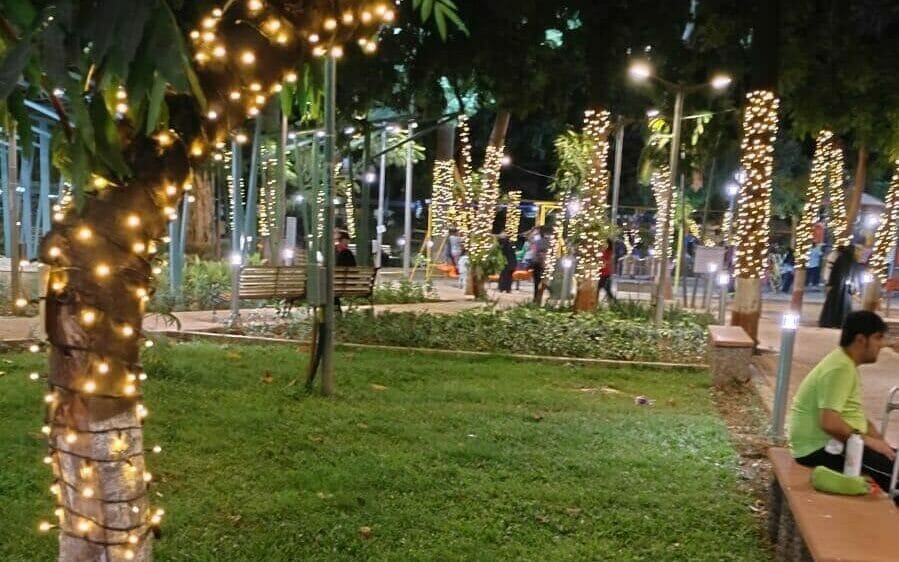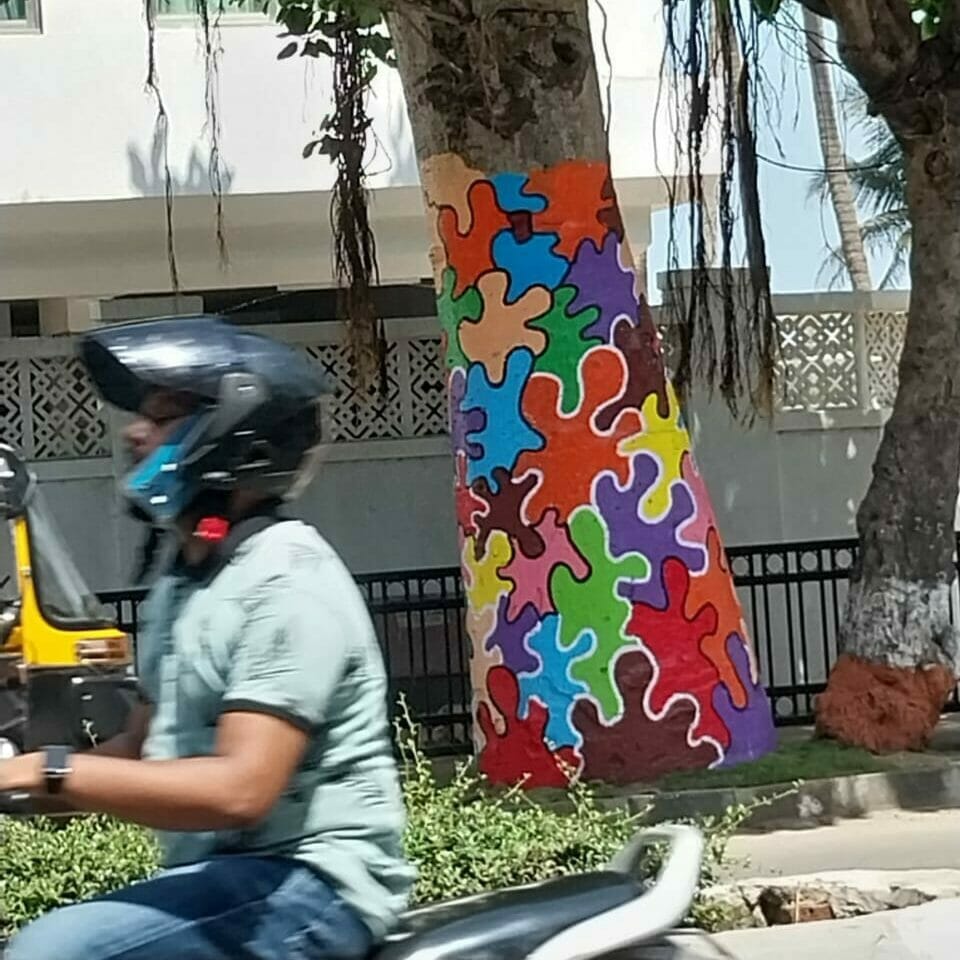In May, Juhu resident Delia Lobo Alva found that many trees in her neighbourhood were getting painted, in a short span of one weekend. But not with the usual white limestone and geru, the natural bug repellants as was the policy decision adopted by the garden department of the Brihanmumbai Municipal Corporation (BMC) earlier. Instead, trees were coloured with bright, garish oil paints that would not come off and would affect the health of the trees.
“I was shocked to see about 11 trees painted on the entire stretch. We considered the oil paint off the bark using turpentine but realised that the chemical would have peeled off the skin of the trees. That would have caused further harm instead of helping the trees. Hence, it was decided to just let it be. I don’t think even the rains would wash them off because it is oil paints,” says Delia.
Active residents like Zoru Bhathena even tweeted about it on May 17,2023 and even complained to the BMC demanding that such action be halted immediately. “Living trees cannot be painted like this. It harms/damages the trees. (Painting the bark of tree is like painting the human skin. A complete No No!) This is NOT Beautification. This is Slow Murder. Kindly remove such paint immediately.”

Following the uproar about this, the BMC stayed the plan in that area, after having painted around 11 trees in and around Juhu. However, they neither explained the actions, nor did they assure that such an initiative would not be undertaken again elsewhere.
After paints, the lights
Apart from painting, the BMC also undertook lighting up of trees at various places. This happened at a wider scale with about 15,000 trees meant to be lit up, a Hindustan Times article informed.

Residents of Bandra’s Almeida Park were surprised to find fairy lights on the trees of the park till 6 am. Residents said the park looked like a wedding venue. Local corporator Asif Zakaria tweeted about it only to find the lights from these trees were transferred to trees on neighbouring roads like Hill Road, St. Andrews Road.
Initially, people assumed that it was part of the initiative to welcome G20 delegates and would be off soon. It was only when the illumination continued, long after the delegates had left, that people realised that these lights were part of the Rs 1729 crore beautification drive by the BMC. As part of this drive, each ward received Rs 30 crore to undertake beautification work resulting in impulsive spending without due consideration for impact on trees and ecology.
Read more: Mumbaikars not impressed with 1729 crore beautification drive
Impact on trees and their ecology
Civic activists said it was not just about the aesthetics, but the harm it inflicts on the trees and the ecology dependent on it. Tree experts say that such continuous lighting up of trees can be unsettling and even harmful for trees in the long run. Arborist and technical expert from the Maharashtra State Tree Authority, Vaibhav Raje says, “A period of darkness is equally important for trees in a day cycle. Bright lights over long durations at night can disrupt a tree’s biological clocks, just like it would in humans. Also the micro-ecology within the tree like birds, insects, bees get affected by the unnatural lighting during night time, as their natural biological patterns get disturbed.”

Oil paints are a no-no too. Vaibhav says painting live, healthy trees can have negative long term effects. “Lenticels (small cellular openings) present on the stems, which help in gaseous exchange and other life processes in a tree can get blocked due to oil paints. It may cause the tree to decline gradually. So, painting over the trunks of live healthy trees should be avoided.” He also advises against installing any kind of lighting cables, fittings or wires directly on to the tree to avoid physical damage to trees.
Lives that depend on the trees like the birds, animals and insects are also affected by such unwise initiatives, feel experts.
“When circumstances are unsuitable, the tree can’t move away but the birds can. And they just tend to move away. It’s a loss of habitat for the birds. When trees are lit up, they are unable to rest. While there are no studies done so far on this, but this could result in a loss of species for the city, says V. Shubhalaxmi, an entomologist, ecologist and founder of Inaturewatch Foundation, adding, “Insects use bark of trees for shelter. The bark also provides camouflage for some animals and protects it from harm from other animals. But, if trees are lit up, then such animals are left vulnerable and might stay away. We must be thoughtful about animals too, when we plan any initiatives related to trees.”
Civic activists urged the BMC to seek expert guidance before embarking on such plans given the environmental impact it may have.
How can we highlight the beauty of trees without disturbing them ?
Citing Singapore as a best example of integrating urban planning with greenery in a city, Vaibhav laments that “the concept of integrating trees into urban design right from the planning stage is yet to fully catch up in our country”.
Vaibhav recommends that with several ongoing mega infrastructure projects in Mumbai, a conscious effort must be made to integrate tree planting strategies, involving experts at early stages of projects. “Also drastic measures are needed to retain our existing greenery, especially large mature trees, to keep our city green and healthy for the next generations.” says Vaibhav.
In an interview to Hindustan Times, municipal commissioner Iqbal Singh Chahal justified the electrical lighting by comparing the lights to blinking stars in a clear sky. He stated that these lights didn’t require any nails to wrap around the tree trunks. He also sought to underplay the overwhelming criticism by stating that the lights had been sourced from the same companies that also provided to Singapore and Dubai and wondered how “no one criticised those cities,” while he is being pulled up for killing trees.
As the BMC is disbanded and run under an administrator, activists say there is lack of transparency about various initiatives in progress. Hence, the only way out for residents is to stay alert about the trees in their locality. In case they observe any such projects being carried, they can lodge complaints at the local ward offices. Collective campaigning on social media and registering their complaints on various public platforms is the way forward.
Ocame to know about u just now. Keep it up we need people who will speak up in a lovely beautiful city like Mumbai. The trams, double decker buses the festivals the republic Day lighting visited late at night etcwhat a joyous city. Now every day when India is reaching for the the moon our infrastructure is crumbling. Why? Due to each and every citizens lethargy and dont care attitude. Lets wake up before it gets too late.